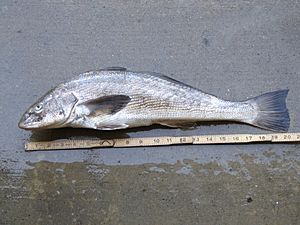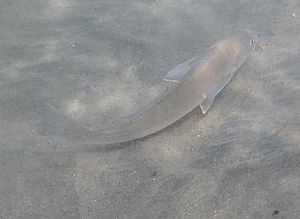California corbina facts for kids
Quick facts for kids California corbina |
|
|---|---|
 |
|
| Conservation status | |
| Scientific classification | |
| Kingdom: | |
| Phylum: | |
| Class: | |
| Order: | |
| Family: |
Sciaenidae
|
| Genus: |
Menticirrhus
|
| Species: |
M. undulatus
|
| Binomial name | |
| Menticirrhus undulatus (Girard, 1854)
|
|
The California corbina (Menticirrhus undulatus) is a type of fish that lives near the bottom of the ocean. It belongs to the croaker family. You can often find these fish along sandy beaches and in shallow bays. They usually travel in small groups in the surf zone, which is where waves break. They can be found in water just a few inches deep, or as deep as 20 meters (66 ft) (about 65 feet). People sometimes call them "California kingcroaker" or "California whiting."
Contents
What Does a California Corbina Look Like?
California corbina are mostly grey in color. They have a slightly shiny, rainbow-like look. Their bodies are long and a bit flat compared to other croakers.
Unlike many fish, the California corbina does not have a swim bladder. A swim bladder is a gas-filled organ that helps fish float. Because they don't have one, they cannot make a croaking sound like other croakers. Scientists think they lost this organ to help them live in the rough, wavy ocean water.
The California corbina has a short, stiff barbel on its lower jaw. A barbel is like a whisker. They use this barbel to find food. The California corbina and the yellowfin croaker are the only two types of croakers in California with this special barbel.
Their tail fin, called the caudal fin, has a unique shape. The top part curves inward, while the bottom part curves outward. The biggest California corbina ever found was 28 inches (710 mm) long and weighed 8.5 pounds.
Where Do California Corbina Live?
California corbina are found from the Gulf of California in Mexico up to Point Conception, California. However, scientists are not completely sure how far south they go. This is because there are other similar fish in the Gulf of California that are easily mistaken for the corbina.
These fish commonly live in the shallow areas and ditches along sandy beaches. They also like shallow bays, in waters up to 20 meters (66 ft) deep. California corbina often swim in small groups. However, adult fish are sometimes seen swimming alone. They search for food in the shallow waters of sandy beaches. They also use the rough, white water from waves to hide.
How Do California Corbina Live?
What Do California Corbina Eat?
The California corbina eats small crustaceans, tiny fish, bivalves (like clams), and other small creatures without backbones. They have been seen eating in water that is only a few inches deep. To eat, they scoop up mouthfuls of sand. Then, they push the sand out through their gills. They also spit out bits of clam shells and other things they don't want to eat.
California Corbina Life Cycle
Male California corbina are ready to have babies when they are about 2 years old and 10 inches long. Females are ready at about 3 years old and 13 inches long. They lay their eggs, which is called spawning, from June to September. The busiest time for spawning is in July and August. Their eggs float freely in the water. Scientists don't know much about how many corbina there are or how long they live.
Fishing for California Corbina
People catch California corbina for both fun (sport fishing) and for selling (commercial fishing). You can catch them all year, but the best time is in summer and late fall.
Because California corbina live close to shore, fishermen usually catch them from beaches, piers, and jetties. They are not often caught from private boats or large fishing ships. Sometimes, shrimp fishing boats accidentally catch them while trying to catch shrimp.
Protecting the California Corbina
The IUCN (a group that studies nature) says that we don't have enough information about the California corbina. This is because there are still questions about where exactly they live.
There are no special efforts just to protect the California corbina. However, some areas where they live are protected by different marine protected areas. These are like national parks for the ocean. The number of corbina caught has gone down since the early 2000s. But scientists are not sure if this means there are fewer fish in the ocean.
See also
 In Spanish: Menticirrhus undulatus para niños
In Spanish: Menticirrhus undulatus para niños




